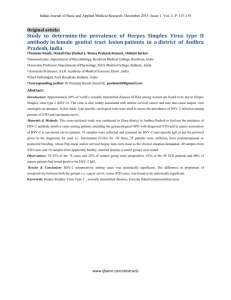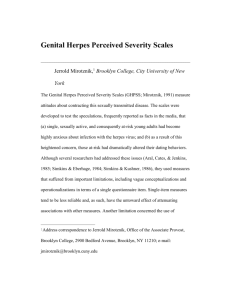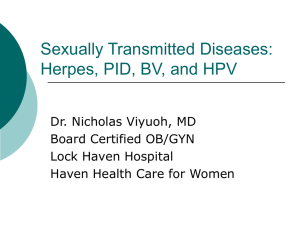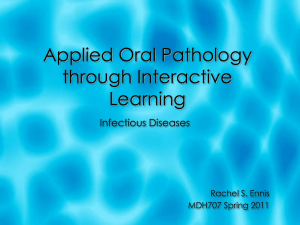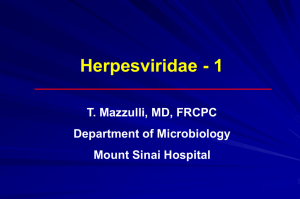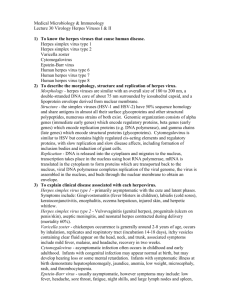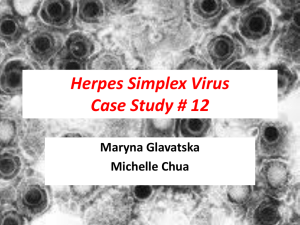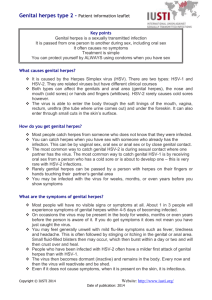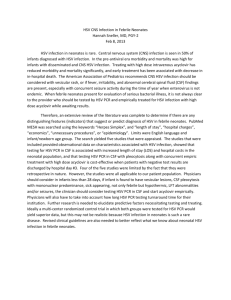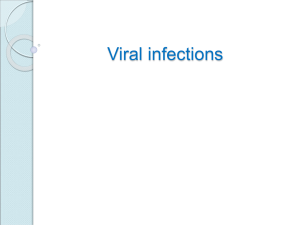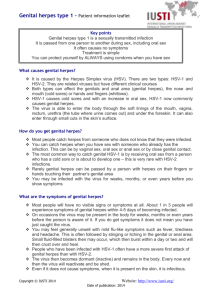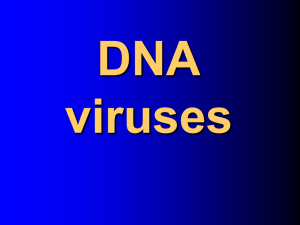Proposal for introducing type specific serologic testing for Herpes
advertisement
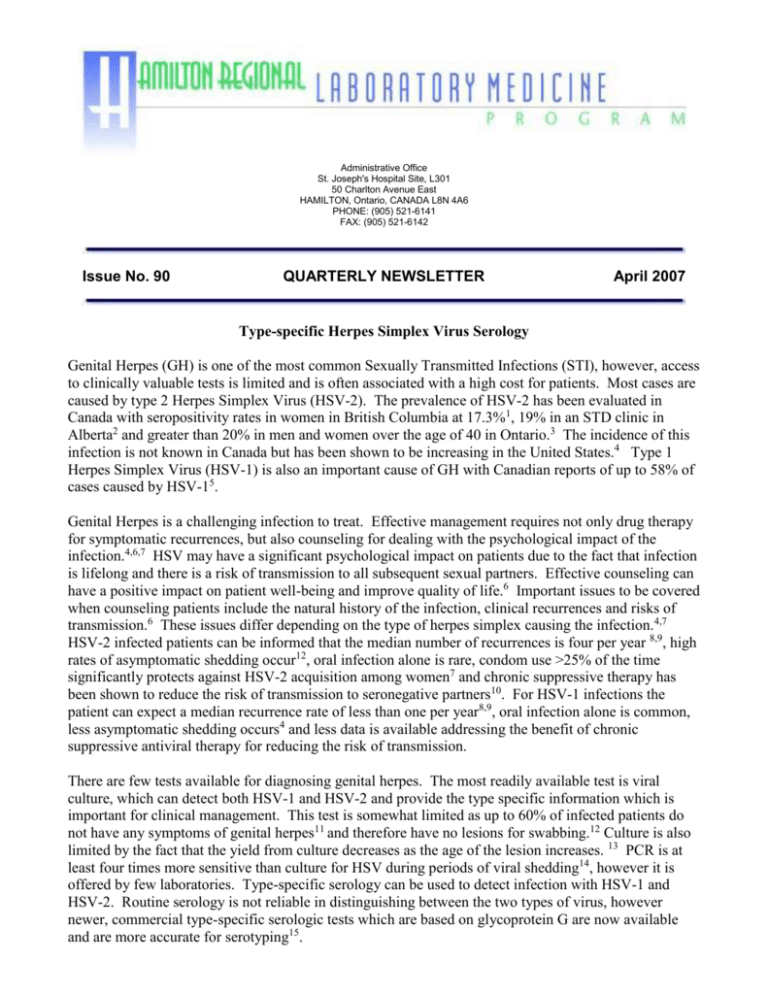
Administrative Office St. Joseph's Hospital Site, L301 50 Charlton Avenue East HAMILTON, Ontario, CANADA L8N 4A6 PHONE: (905) 521-6141 FAX: (905) 521-6142 Issue No. 90 QUARTERLY NEWSLETTER April 2007 Type-specific Herpes Simplex Virus Serology Genital Herpes (GH) is one of the most common Sexually Transmitted Infections (STI), however, access to clinically valuable tests is limited and is often associated with a high cost for patients. Most cases are caused by type 2 Herpes Simplex Virus (HSV-2). The prevalence of HSV-2 has been evaluated in Canada with seropositivity rates in women in British Columbia at 17.3%1, 19% in an STD clinic in Alberta2 and greater than 20% in men and women over the age of 40 in Ontario.3 The incidence of this infection is not known in Canada but has been shown to be increasing in the United States.4 Type 1 Herpes Simplex Virus (HSV-1) is also an important cause of GH with Canadian reports of up to 58% of cases caused by HSV-15. Genital Herpes is a challenging infection to treat. Effective management requires not only drug therapy for symptomatic recurrences, but also counseling for dealing with the psychological impact of the infection.4,6,7 HSV may have a significant psychological impact on patients due to the fact that infection is lifelong and there is a risk of transmission to all subsequent sexual partners. Effective counseling can have a positive impact on patient well-being and improve quality of life.6 Important issues to be covered when counseling patients include the natural history of the infection, clinical recurrences and risks of transmission.6 These issues differ depending on the type of herpes simplex causing the infection.4,7 HSV-2 infected patients can be informed that the median number of recurrences is four per year 8,9, high rates of asymptomatic shedding occur12, oral infection alone is rare, condom use >25% of the time significantly protects against HSV-2 acquisition among women7 and chronic suppressive therapy has been shown to reduce the risk of transmission to seronegative partners10. For HSV-1 infections the patient can expect a median recurrence rate of less than one per year8,9, oral infection alone is common, less asymptomatic shedding occurs4 and less data is available addressing the benefit of chronic suppressive antiviral therapy for reducing the risk of transmission. There are few tests available for diagnosing genital herpes. The most readily available test is viral culture, which can detect both HSV-1 and HSV-2 and provide the type specific information which is important for clinical management. This test is somewhat limited as up to 60% of infected patients do not have any symptoms of genital herpes11 and therefore have no lesions for swabbing.12 Culture is also limited by the fact that the yield from culture decreases as the age of the lesion increases. 13 PCR is at least four times more sensitive than culture for HSV during periods of viral shedding14, however it is offered by few laboratories. Type-specific serology can be used to detect infection with HSV-1 and HSV-2. Routine serology is not reliable in distinguishing between the two types of virus, however newer, commercial type-specific serologic tests which are based on glycoprotein G are now available and are more accurate for serotyping15. - 2 Type-specific serology is useful for managing select populations such as pregnant women, discordant couples (where one has a herpes infection and is seropositive, the other does not and is seronegative), HIV infected patients, patients with atypical lesions, and high risk patients 15,16. Patients who are seropositive for HSV-2 have genital herpes4 while HSV-1 seropositivity must be interpreted in the context of the clinical presentation. Despite its clinical utility, type specific serology for herpes simplex virus is not widely available and has a price tag which prohibits its use in many patients. 1) Patrick DM, Dawar M, Cook DA, Krajden, Ng HC, Rekart ML. Antenatal seroprevalence of Herpes simplex virus type 2 (HSV-2) in Canadian women: HSV-2 prevalence increases throughout the reproductive years. Sex Trans Dis. 2001; 28:424-428. 2) Singh AE, Romanowski B, Wong T et al. Herpes simplex virus seroprevalence and risk factors in 2 Canadian sexually transmitted disease clinics. Sex Trans Dis 2005; 32: 95-100. 3) Howard M, Sellers JW, Jang D, Robinson N.J, Fearon M, Kaczorowski J and Chernesky M. Regional Distribution of Antibodies to Herpes Simples virus Type 1 (HSV-1) and HSV-2 in men and women in Ontario, Canada. J Clin Micro 2003; 41(1): 84-89. 4) Aoki F.Y. Genital Herpes Simples Virus. Canadian STD Treatment Guidelines. 2006. 5) Forward KR, Lee SHS. Predominance of herpes simplex virus type 1 from patients with genital herpes in Nova Scotia. Can J Infect Dis 2003; 14:94-6. 6) Clarke P. The impact of a herpes diagnosis and the implications for patient counseling. In: Sacks SL, Straus SE, Whitley RJ, Griffiths PD, eds. Clinical Management of Herpes Viruses. Burke, VA: IOS Press, Inc.; 1995:75-86. 7) Leone P. Reducing the risk of transmitting genital herpes: advances in understanding and therapy. Current Medical Red and Opin. 2005; 21(10):1577-82.Corey L, Adams HG, Brown ZA et al. Genital herpes simplex virus infections: Clinical manifestations, course and complications. Ann Intern Med. 1982;98:958-72. 9) Benedetti J, Corey L, Ashley R. Recurrence rates in genital herpes after symptomatic first-episode infections. Ann Intern Med. 1994; 121:847-54. 10) Corey et al. Once-Daily Valacyclovir to reduce the risk of transmission of genital herpes. New England J Med. 2004; 350:11-20. 11) Corey L, Adams HG, Brown ZA, Holmes KK. Genital herpes simples infections: clinical manifestations, course and complications. Ann Intern Med. 1983; 98:958-972. 12) Mertz G.J, Benedetti J, Ashley R, Selke SA, Corey L. Risk factors for the transmission of genital herpes. Ann Intern Med. 1992; 116:197-202. 13) Kimberlin D.W, Rouse D.J. Genital herpes. New England J Med. 2004; 350:1970-77. 14) Wald A, Huang M-L, Carrell D, Selke S, Corey L. Polymerase chain reaction for detection of herpes simples virus (HSV) on mucosal surfaces: comparison with HSV isolation in cell culture. J Infect Dis. 2003; 188:1345-51. 15) Wald A, Ashley-Morrow R. Serological testing for Herpes Simplex Virus (HSV)-1 and HSV-2 Infection. CID. 2002; 35: 173-182. 16) Guerry S.L, Bauer H.M, Klausner J.D, Branagan B, Kerndt P.R, Allen B.G and Bolan G. Recommendations for the selective use of herpes simples virus type 2 serological tests. CID. 2005; 40: 38-45. Dr. Cheryl Main Discipline of Microbiology Directory, Hamilton STI Clinic Hamilton Regional Laboratory Medicine Program Hamilton General Hospital Site
